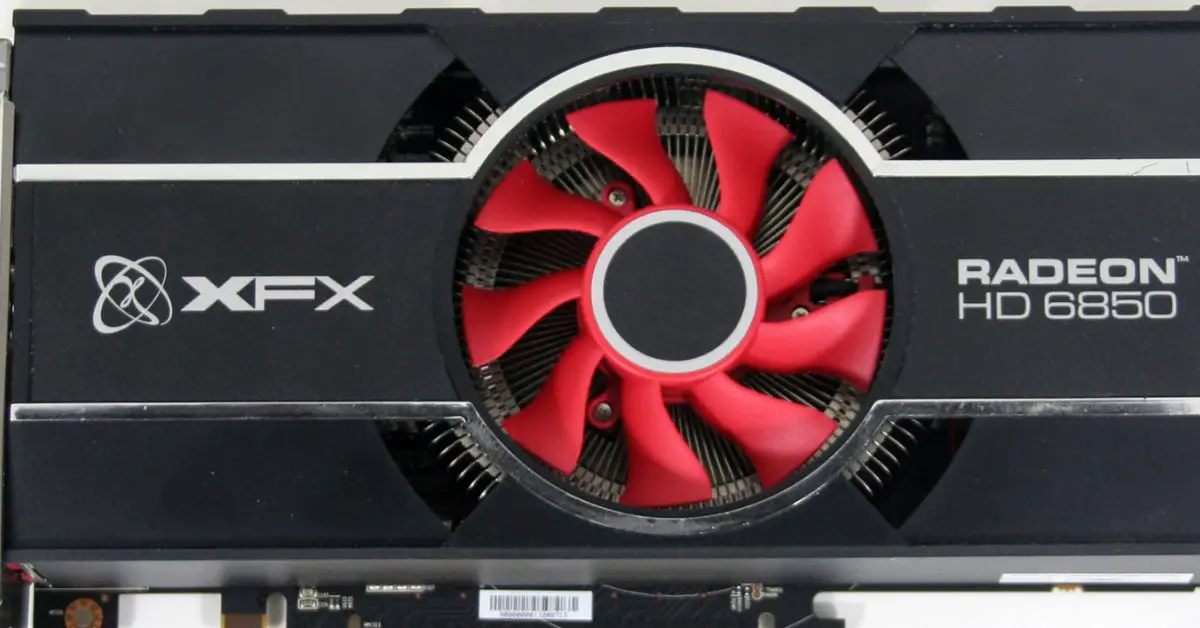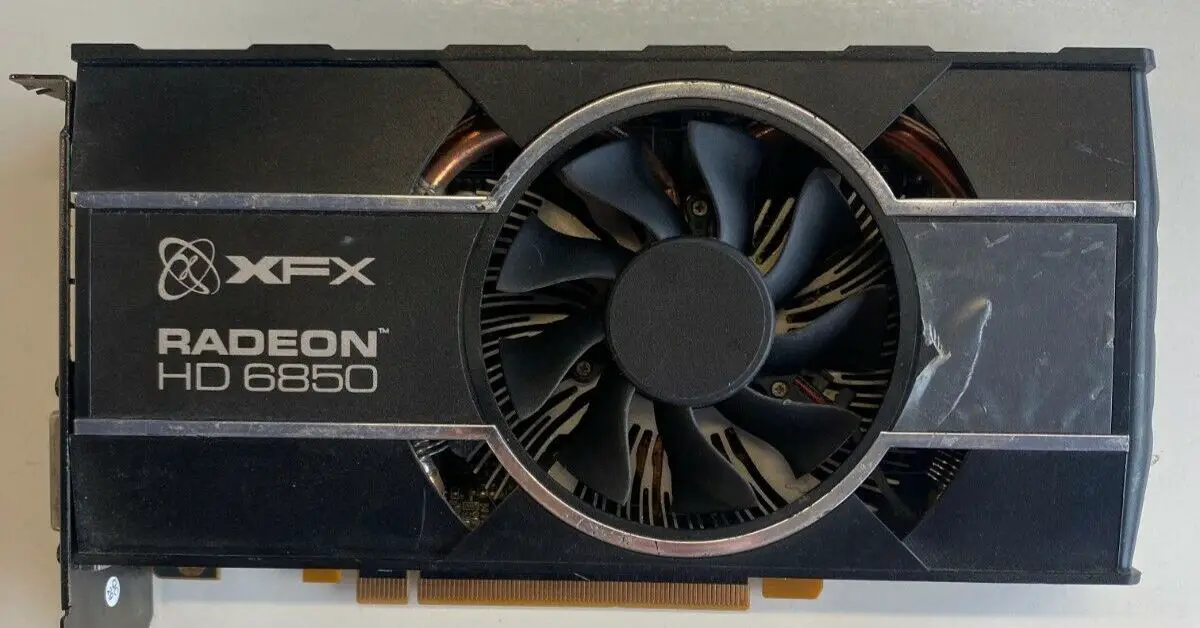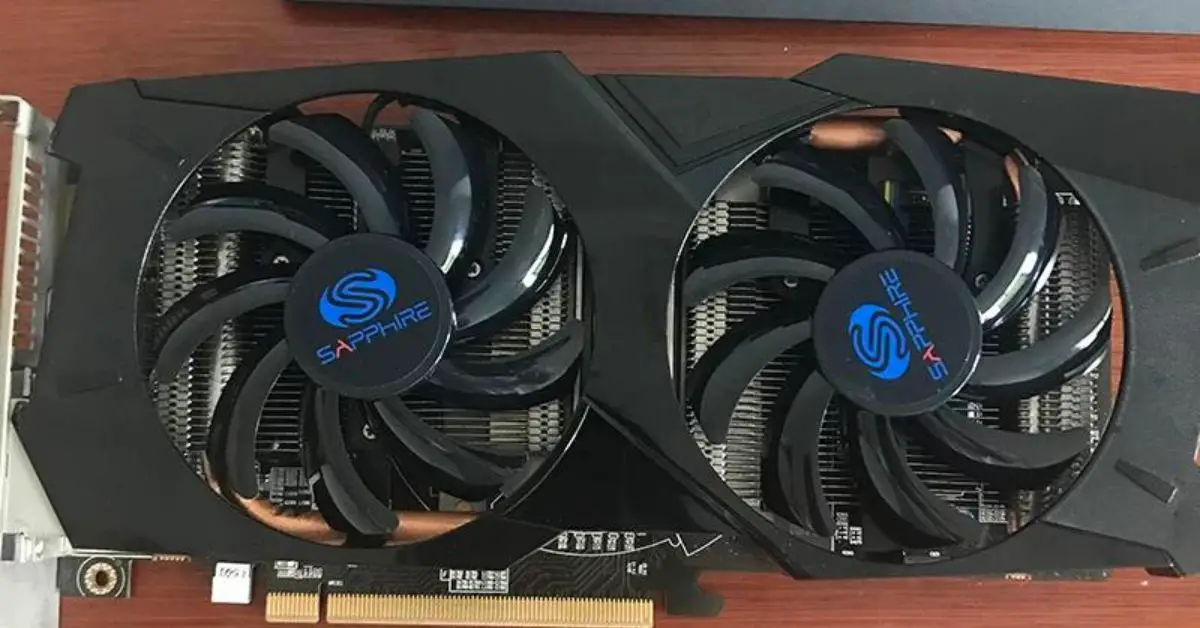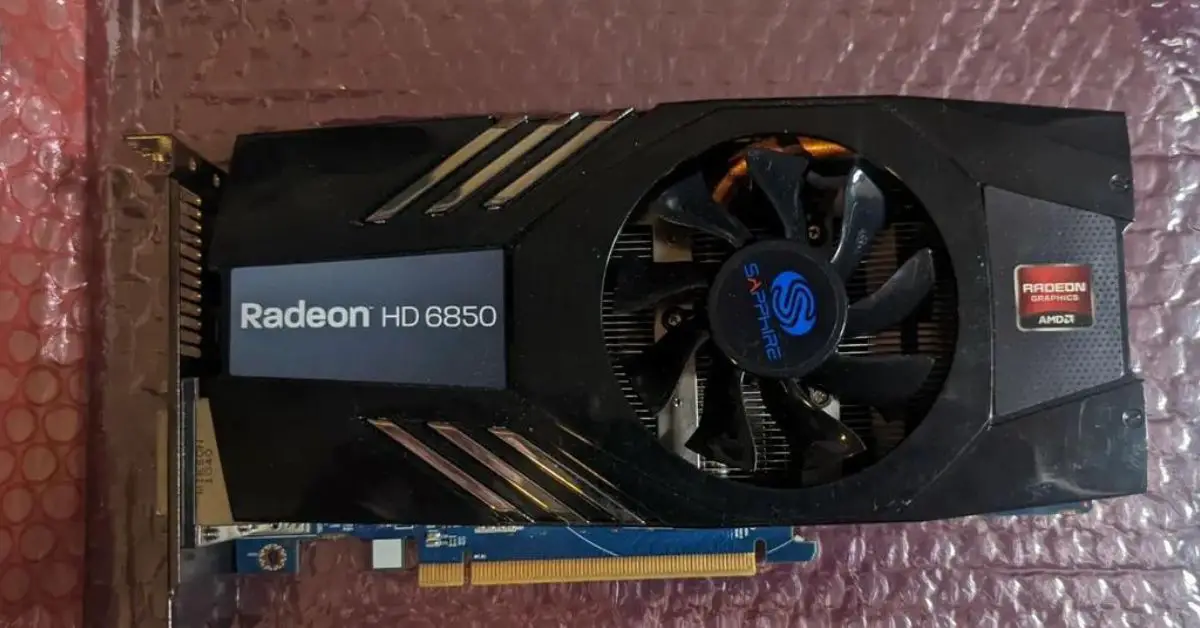The AMD Radeon HD 6850 was a mid-range graphics card released by AMD (formerly ATI Technologies) as part of their Radeon HD 6000 series. It made its debut in October 2010 and was designed to cater to gamers and PC enthusiasts seeking a balance between performance and affordability.
Key features and specifications of the Radeon HD 6850 included:
- Architecture: The HD 6850 was based on AMD’s “Barts” GPU architecture, built on a 40nm manufacturing process. It featured improved power efficiency and performance compared to its predecessors.
- GPU Specifications: The card had 960 stream processors, a core clock speed typically around 775 MHz, and 1GB of GDDR5 memory running at an effective clock speed of 4.0 GHz on a 256-bit memory interface.
- Performance: Positioned as a mid-range card, the HD 6850 offered decent gaming performance at 1080p resolution for many contemporary games at the time of its release. It wasn’t a top-tier performer but provided good value for its price point.
- Technological Features: The Radeon HD 6850 supported DirectX 11, AMD Eyefinity multi-display technology, and AMD’s HD3D for stereoscopic 3D gaming experiences.
- Power Consumption: It had relatively low power consumption compared to some higher-end cards, making it suitable for a wide range of computer builds without requiring excessive power supplies.
Historical Context and Release Information
The Radeon HD 6850 was released during a competitive period in the GPU market, where both AMD and NVIDIA were striving to offer compelling solutions at various price points. Its launch was part of AMD’s strategy to address the mid-range gaming market by offering a card that delivered good performance without breaking the bank.
At the time, it competed with NVIDIA’s GeForce GTX 460 and found its place among gamers seeking a balance between price and performance. While it wasn’t the most powerful card in its generation, its competitive pricing and decent capabilities made it a popular choice for budget-conscious gamers and users looking for a capable graphics solution.
Its legacy lies in being a reliable mid-range option during the transition to DirectX 11 gaming and serving as a stepping stone for AMD towards refining its GPU architectures for future iterations. As newer generations of graphics cards emerged, the HD 6850 eventually became outdated, but it remains a part of AMD’s history for its value and performance during its time.
Contents
- Radeon HD 6850: Technical Specifications
- AMD Radeon HD 6850: Performance and Benchmarking
- AMD Radeon HD 6850: Features and Technologies
- AMD Radeon HD 6850: Cooling and Design
- AMD Radeon HD 6850: Compatibility and System Requirements
- AMD Radeon HD 6850: Overclocking Potential and Software
- Radeon HD 6850 vs GTX 1050
Radeon HD 6850: Technical Specifications
| Specifications | Details |
|---|---|
| GPU Architecture | “Barts” |
| Fabrication Process | 40nm |
| Core Clock Speed | ~775 MHz |
| Stream Processors | 960 |
| Memory | 1GB GDDR5 |
| Memory Interface | 256-bit |
| Memory Speed | Effective 4.0 GHz |
| Memory Bandwidth | Up to 128 GB/s |
| TDP (Thermal Design Power) | Approximately 127 Watts |
| Power Connectors | Two 6-pin PCIe connectors |
GPU Architecture and Technology:
- Architecture: “Barts” GPU architecture by AMD.
- Fabrication Process: Built on a 40nm process technology.
Core Clock Speed and Memory:
- Core Clock Speed: Typically ran at around 775 MHz.
- Stream Processors: 960.
- Memory: 1GB GDDR5 VRAM.
Memory Bandwidth and Interface:
- Memory Interface: 256-bit.
- Memory Speed: Operated at an effective speed of 4.0 GHz.
- Memory Bandwidth: Calculated by multiplying the memory clock speed by the memory bus width, resulting in a theoretical maximum memory bandwidth of 128 GB/s.
TDP (Thermal Design Power) and Power Connectors:
- Thermal Design Power (TDP): The HD 6850 had a TDP typically around 127 Watts.
- Power Connectors: Generally required two 6-pin PCIe power connectors for power delivery.
The card was designed to offer a balance between performance and power efficiency, with a reasonable TDP that made it suitable for a range of desktop systems without requiring extremely high-power PSUs.
The memory bandwidth and the 256-bit memory interface, coupled with the core clock speed and stream processor count, allowed the Radeon HD 6850 to deliver decent gaming performance for its time, especially for 1080p gaming, making it a popular choice among mid-range gamers and PC enthusiasts.
AMD Radeon HD 6850: Performance and Benchmarking
Gaming Performance – FPS (Frames Per Second) in Popular Games
The AMD Radeon HD 6850 was capable of delivering smooth gameplay in many popular games of its time at 1080p resolution with medium to high settings. Here are approximate FPS values for some games:
- Assassin’s Creed: Odyssey: Around 40-45 FPS on medium settings.
- The Witcher 3: Approximately 35-40 FPS on medium to high settings.
- Fortnite: Achieved around 60-70 FPS on medium settings.
- GTA V: Ran at approximately 45-50 FPS on medium settings.
- Overwatch: Attained around 70-80 FPS on medium to high settings.
These figures may vary based on system configurations, driver optimizations, and in-game settings.
Comparison with Competing GPUs
At its release, the Radeon HD 6850 competed primarily with NVIDIA’s GeForce GTX 460. In general, the performance of the HD 6850 was quite comparable to the GTX 460, with both cards offering similar gaming experiences in many titles.
However, specific performance differences could be seen depending on the game and driver optimizations.
Compute Performance and Efficiency
The Radeon HD 6850 showcased respectable compute performance for its time, especially considering its mid-range classification. It supported OpenCL and had compute capabilities suitable for various non-gaming tasks like video encoding, rendering, and general-purpose computing.
In terms of efficiency, while it wasn’t the most power-efficient card in its generation, the HD 6850 offered a decent balance between performance and power consumption. Its TDP of around 127 Watts made it a reasonable choice for mid-range gaming PCs without requiring excessively high-powered PSUs.
AMD Radeon HD 6850: Features and Technologies
DirectX and OpenGL Support
- DirectX Support: The Radeon HD 6850 supported DirectX 11, allowing it to take advantage of advanced graphical features and optimizations in games designed for DirectX 11.
- OpenGL Support: It also provided support for OpenGL, an open standard for rendering 2D and 3D graphics, enabling compatibility with
- OpenGL-based applications and games.
AMD Eyefinity Technology
Eyefinity was a significant feature introduced by AMD, allowing the Radeon HD 6850 to drive multiple displays from a single graphics card. It enabled immersive gaming or enhanced productivity by stretching the desktop across multiple monitors, providing a panoramic view or more screen real estate for multitasking.
CrossFireX Support
The HD 6850 supported AMD’s CrossFireX technology, enabling users to combine multiple Radeon HD 6850 cards in a CrossFireX configuration for increased performance in compatible games. This technology utilized multiple GPUs to work together and render frames more efficiently, improving overall gaming performance.
Other Notable Features
- HD3D Technology: The HD 6850 supported AMD’s HD3D, allowing users to experience stereoscopic 3D gaming and content when using compatible 3D displays or glasses.
- PowerTune Technology: AMD’s PowerTune was a feature that dynamically adjusted GPU settings in real-time to optimize performance and power consumption based on workload and thermal constraints.
- AMD App Acceleration: This technology utilized the GPU’s parallel processing power to accelerate supported applications, such as video editing, transcoding, and image processing, enhancing their performance.
- Video Playback and Decoding: The HD 6850 provided hardware-accelerated video playback and decoding for high-definition content, offering smooth playback and reducing CPU usage during multimedia tasks.
AMD Radeon HD 6850: Cooling and Design
Cooling System Overview
- The Radeon HD 6850 came with various aftermarket cooling solutions from different manufacturers, which might have included single or dual-fan designs, as well as different heat pipe configurations.
- Typically, these cards featured a fan or fans attached to a heatsink, which helped dissipate heat generated by the GPU during operation.
Form Factor and Physical Design
- The HD 6850 adhered to the standard form factor for graphics cards, fitting into a PCIe x16 slot on a compatible motherboard.
- The physical dimensions of the card varied slightly between different manufacturers, but it generally followed a dual-slot design, meaning it occupied two expansion slots in the PC case.
AMD Radeon HD 6850: Compatibility and System Requirements
System Requirements for Installation
- PCIe x16 slot on the motherboard.
- Adequate power supply with at least two 6-pin PCIe power connectors.
- Sufficient airflow and space inside the PC case to accommodate the dual-slot design.
Compatibility with Different Operating Systems
- The Radeon HD 6850 was compatible with various operating systems, including Windows (Windows 7, Windows 8, Windows 10), Linux distributions with compatible drivers, and earlier versions of Windows, though driver support might vary.
- It’s essential to note that while the card was compatible with different operating systems, optimal performance and feature support often depended on the availability and quality of drivers provided by AMD for specific operating systems.
- To install the Radeon HD 6850, users needed to ensure their PC met the system requirements and had the necessary power connectors available from the PSU. The card would fit into the appropriate PCIe slot on the motherboard and require appropriate drivers to be installed to function correctly.
Lastly, compatibility with various PC cases should be considered due to the dual-slot design and the physical dimensions of the card. Ensuring sufficient space and proper airflow within the case would contribute to optimal performance and cooling of the graphics card.
AMD Radeon HD 6850: Overclocking Potential and Software
Overclocking Capabilities
- The AMD Radeon HD 6850 offered some overclocking headroom for enthusiasts willing to push its performance beyond stock settings. Users could potentially increase the core clock speed and memory frequency using various overclocking utilities provided by AMD or third-party software.
- However, the extent of overclocking largely depended on the individual GPU’s silicon quality and thermal headroom, which varied between different cards.
- Overclocking carried risks and could void warranties if not performed correctly. Users were advised to proceed cautiously and within safe limits to avoid damaging the card.
AMD Radeon Software Features
- The Radeon HD 6850 was supported by AMD’s Radeon Software suite, which included features such as driver updates, game optimizations, and various settings to customize graphics performance.
- Radeon Software offered tools for adjusting display settings, creating game profiles, monitoring GPU performance, and managing software updates to optimize the user experience with the graphics card.
Common Issues and Troubleshooting
- While the Radeon HD 6850 was generally a reliable card, some common issues reported by users included driver-related problems, occasional graphical artifacts, or overheating due to insufficient cooling.
- Solutions for driver-related issues often involved updating to the latest drivers or performing a clean reinstall of the graphics drivers using AMD’s software suite.
- Overheating issues might be resolved by ensuring proper airflow in the PC case or by using custom fan profiles to improve cooling.
Customer Support and Warranty Information
- Customer support for the Radeon HD 6850 varied among manufacturers who produced cards based on this GPU. Users were typically directed to contact the manufacturer for warranty-related queries or technical support.
- Warranty periods also varied by manufacturer, but most cards came with a standard warranty period, typically around 2 to 3 years, covering defects in materials or workmanship. However, overclocking the card might void the warranty, so it’s crucial to check the manufacturer’s warranty terms before attempting any overclocking.
Radeon HD 6850 vs GTX 1050
Performance
- AMD Radeon HD 6850: The HD 6850 was a mid-range card released in 2010, providing decent performance for its time at 1080p resolution in many games. However, compared to modern standards, its performance might fall short in handling newer and more demanding titles at higher settings.
- NVIDIA GeForce GTX 1050: The GTX 1050, released in 2016, offers significantly better performance compared to the HD 6850. It’s capable of handling modern games at 1080p resolution with reasonable settings, providing smoother gameplay and improved frame rates.
Technological Advancements
- AMD Radeon HD 6850: The HD 6850 supported DirectX 11, had 1GB GDDR5 VRAM, and offered features like AMD Eyefinity for multi-monitor setups and CrossFireX for multi-GPU configurations.
- NVIDIA GeForce GTX 1050: The GTX 1050 also supports DirectX 12 and features 2GB or 4GB GDDR5 VRAM variants. It supports NVIDIA technologies like NVIDIA Ansel for in-game photography and supports NVIDIA’s ecosystem of features and optimizations.
Power Efficiency and Compatibility
The GTX 1050 generally offers better power efficiency compared to the HD 6850, consuming less power while delivering better performance. It also has a lower thermal design power (TDP), making it more suitable for smaller form factor builds.
Pricing and Availability
As the HD 6850 is an older model and is no longer in production, the GTX 1050 might be more readily available in the market, and you may find it easier to acquire a new GTX 1050 compared to the HD 6850.
The NVIDIA GeForce GTX 1050 outperforms the AMD Radeon HD 6850 by a significant margin due to its newer architecture and technological advancements. The GTX 1050 offers better performance, power efficiency, and support for modern features, making it a more suitable choice for gaming and multimedia tasks compared to the older HD 6850.
In conclusion, when considering a graphics card between the AMD Radeon HD 6850 and the NVIDIA GeForce GTX 1050:
- Performance: The GTX 1050 outperforms the HD 6850 by a notable margin in terms of raw performance and efficiency, especially in handling modern gaming titles at 1080p resolution.
- Technological Advancements: The GTX 1050 features newer technologies, improved power efficiency, and supports modern gaming features compared to the aging HD 6850.
- Availability: As the HD 6850 is an older GPU that’s no longer in production, finding brand-new models might be challenging compared to the readily available GTX 1050.
Considering these factors, the NVIDIA GeForce GTX 1050 is a more suitable choice for gaming or multimedia tasks due to its better performance, power efficiency, and compatibility with modern games and software.
If given the choice between these two GPUs, the GTX 1050 would be the recommended option for an improved gaming experience and overall performance on current systems.

Information Security Asia is the go-to website for the latest cybersecurity and tech news in various sectors. Our expert writers provide insights and analysis that you can trust, so you can stay ahead of the curve and protect your business. Whether you are a small business, an enterprise or even a government agency, we have the latest updates and advice for all aspects of cybersecurity.





